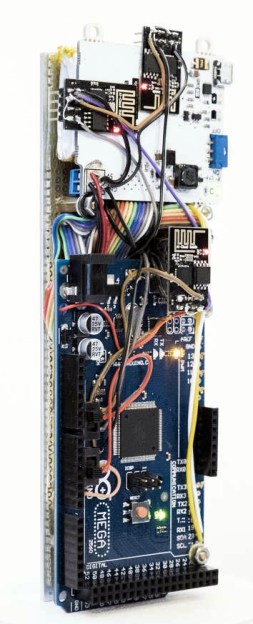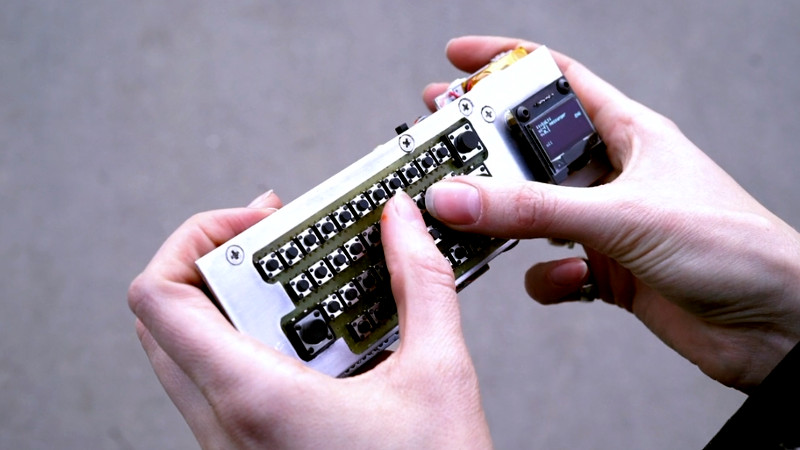We use the Internet to do everything from filing our taxes to finding good pizza, but most critically it fulfills nearly all of our communication needs. Unfortunately, this reliance can be exploited by those pulling the strings; if your government is trying to do something shady, the first step is likely to be effecting how you can communicate with the outside world. The Internet is heavily censored and monitored in China, and in North Korea the entire country is effectively running on an intranet that’s cutoff from the wider Internet. The need for decentralized information services and communication is very real.
 While it might not solve all the world’s communication problems, [::vtol::] writes in to tell us about a very interesting communication device he’s been working on that he calls “Hot Ninja”. Operating on the principle that users might be searching for accessible Wi-Fi networks in a situation where the Internet has been taken down, Hot Ninja allows the user to send simple messages through Wi-Fi SSIDs.
While it might not solve all the world’s communication problems, [::vtol::] writes in to tell us about a very interesting communication device he’s been working on that he calls “Hot Ninja”. Operating on the principle that users might be searching for accessible Wi-Fi networks in a situation where the Internet has been taken down, Hot Ninja allows the user to send simple messages through Wi-Fi SSIDs.
We’ve all seen creatively named Wi-Fi networks before, and the idea here is very much the same. Hot Ninja creates a Wi-Fi network with the user’s message as the SSID in hopes that somebody on a mobile device will see it. The SSID alone could be enough depending on the situation, but Hot Ninja is also able to serve up a basic web page to devices which actually connect. In the video after the break, [::vtol::] even demonstrates some rudimentary BBS-style functionality by presenting the client devices with a text field, the contents of which are saved to a log file.
In terms of hardware, Hot Ninja is made up of an Arduino Mega coupled to three ESP8266 boards, and a battery to keep it all running for up to eight hours so you can subvert a dictatorship while on the move. The user interface is provided by a small OLED screen and a keyboard made entirely of through-hole tactile switches, further reinforcing the trope that touch-typing will be a must have skill in the dystopian future. It might not be the most ergonomic device we’ve ever seen, but the fact it looks like something out of a Neal Stephenson novel more than makes up for it in our book.
This is not the first time we’ve seen Wi-Fi SSIDs used as a method of communication, thanks largely to how easy the ESP8266 makes it. For his part, [::vtol::] has previously experimented with using them to culturally enrich the masses.
















Interesting.
I can see a bunch of these in the hands of anarchists causing widespread dissemination of information quickly.
Oh, but I think the keyboard is much to small for a gorilla to use.
B^)
https://www.youtube.com/watch?v=J9VK92qp7VY
After Snowden disclosed that the NSA also had tools for discovering IP-tunneling traffic, we have all been in need for something different no one have ever heard about. Wait!… Oh bummer.
I wonder if anyone has hacked one of those handheld keyboards like the Rii i8 or clones to use the buttons for something like this. I could envision the trackpad area being replaced by a little LCD screen. I might order one to teardown if I ever get some free time.
https://images-na.ssl-images-amazon.com/images/I/51QBlMNslfL._SL500_AC_SS350_.jpg
Seems a good idea, indeed… It happens I have one, and the touchpad area quite fits the e-paper module I bought from waveshare (https://www.waveshare.com/1.54inch-e-Paper-Module.htm).
Just to let you know…
they have plenty of spare room inside
you can find them for under $10 on ebay
Good idea, but it’s awfully conspicuous looking. In an authoritarian oppressive surveillance-heavy country, say, England (/s), if it’s known this kind of thing is going on, then the authorities will take great interest in a device like this in plain sight. You’ll have to keep it out of view making it difficult to maintain contact.
Now if it looks like a normal phone or communications device such as Doc Octs suggestion, then it’ll look far less suspicious.
Also, try taking that thing through an airport! Rubber gloves up the arse time! I mean that thing might as well have’dynamite’ written on it!
Implant my manifesto into my DNA, and start shedding it all over the place. What are they going to do to stop me?
Flamethrower?
UV light ?
Ostracus – in the Bourne movie franchise they used a human implanted LASER mini-projector under Bourne’s skin. It was just a short number sequence to a numbered bank account in Switzerland I think. This technology the OP is talking about is called electronic dead drop or SRAC (https://en.wikipedia.org/wiki/Short-range_agent_communications). However, whatever you do do NOT use the British approach to SRAC in 2006 in Moscow (click on ref #5). In the imortal words of Homer Simpson – “D’oh!”. :-)
Needs to be combined with compact solar powered modules that set up a secure mesh network for command and control because you really don’t want to risk being caught with such a device rather than just a normal phone that can connect to the mesh to administer it without detection. Because does have a track record of killing people that undermine his propaganda machine. Another neat idea would be to have a rapid way of incorporating the nodes into a light fitting in public places and transport so that the node can have a power source and be hidden. I’d like to see a way of using magnetics to use a continuously loaded AC power cable without cutting it to. Energy of one form or another is ubiquitous in big cities and it is a key enabler for such a shadow network so that whole area needs a lot of attention. The rest will just get easier as the computer/radio hardware gets smaller and cheaper while the software improves.
Because [tyrant] does have a track record….
He does know that Wi-Fi signals can be triangulated, right?
But, if he keeps moving, and like a snake, sheds his skin on occasion (changes WiFi name or shuts off if “interested” people show up). And if a number of people have them and keep drifting in and out of “hot zones”.
But yes, disguising it as something else that can be shut off/ reconfigured remotely, as other commenters have mentioned, even better.
Best approach is to run a numbers station on a streaming broadcast Internet site. This would be like the virtual shortwave simulator audio streaming site HamSphere . And guess what? Somebody is already doing it.
Run it from anywhere like a Internet coffee shop over its open wi-fi on a hidden laptop with voice synth. That way if it is traced to the coffee shop, who cares, just do the Mission Impossible thing! :-D
https://www.youtube.com/watch?v=fkXGGhuQs0o
This keyboards looks soooo painful. I build a gamepad for my C64 using same microswitches when I was ~12, lasted <hour playing Elite before giving up and improvising key caps from random plastic bits.
Why three ESP8266? website mentions number of characters in SSID and how 3 radios extend that, this makes no sense, you can beam thousands of SSIDs from one ESP8266 (esp8266_beaconSpam on github).
I suppose three esp’s are used to cover the three Wi-Fi channels (1,6,11) simultaneously ?
I’ve been using MDK3 to broadcast the lines of Aaron Swartz’s manifesto all simultaneously for years. All you have to do is get the broadcast frame timing right and an entire paragraph shows up on the wifi list of every device in range.
I love the idea, but as others are commenting, I would love to do this from a normal smartphone for a more subtle, easy and mainstream way of doing this. A smartphone already has everything you need, right? (WiFi hotspot, keyboard, etc… except the battery life, and that can be solved with an external battery).
Does anyone know of an app that can do just that? Basically enabling a WiFi hotspot with no Internet connection, setting a custom SSID name and redirecting every connected users to a static website, without showing any other information about the phone or allowing any other kind of interaction. Kind of a simplified mobile web server or PirateBox app…
Jorge – Most Smartphones, like the ZTE Awe, have portable hot spot setting under the Settings menu. You can set the broadcast SSID at will. You may not be allowed to use long sentences as the text limit is probably set to 255 or less. Also your service provider may not allow setting up hot spots. You’ll have to use something like FoxFi or PDANET. If you also attach to the same hot spot then you could put a static HTML file in your root somewhere and someone could read your messages. Saving return-reply text messages is problematic.However, users would have to have access to your root. You could run a web-server on port 8080. Not sure how to do that on a cell phone.
Another approach to walk-around with a SSID broadcast message is to go a local thrift store like Goodwill, look for a a cheap small sized Wi-Fi router like a Linksys, Belkin, Cisco, etc (no external antennas for low profile look). Get a 12 volt battery pack with the appropriate power plug for your router. Tape it to the side. Then run it in hot spot mode. If you plug your portable laptop or notebook into it’s RJ45 hub port, you can use your browser to log into its admin account via lets say 198.162.1.1 using default admin & password login. It would be easier to run a port 8080 webserver from your laptop plugged in like Microsoft’s FrontPage has built-in for free. You could run a 2-way BBS discussion board via FrontPage’s built in Discussion Wizard function for that.
Thanks for the reply. Setting up a web server should’t be very complicated. I’ve seen several apps that make it relatively easy to do. The question would be how to automatically redirect anyone to the local website as soon as they connect to the hotspot, “captive portal” style. I’ll look into that.
Jorge – I would think that any Access Point or Hot Spot program you use would have a “captive portal” function like some sort of HTTP Redirect parameter you can set check or uncheck the box (you’d put in a redirect URL from there). But in the scenario I think you are envisioning is one that is not end-user friendly like that but a bit surreptitious like for hackers and such (looking for a secret BBS?). That way after logging into your hot spot it just sits there with no action – blank ABOUT:BLANK white screen. It would be up to your local DHCP/DNS server to resolve anything typed into the browser’s URL window to your captive portal. No DHCP or DNS server? Then give your friends a TCPIP address to type in to get to your local webpage. Just put that IP address in the SSID too. I’d think hackers would appreciate the labor intensive Easter-egg approach.
Here’s you walking around with portable hot-spot website with Belkin mini AP router and a 12 volt gel-cell battery in backpack
https://thumbs.dreamstime.com/b/computer-geek-carrying-laptop-17797936.jpg